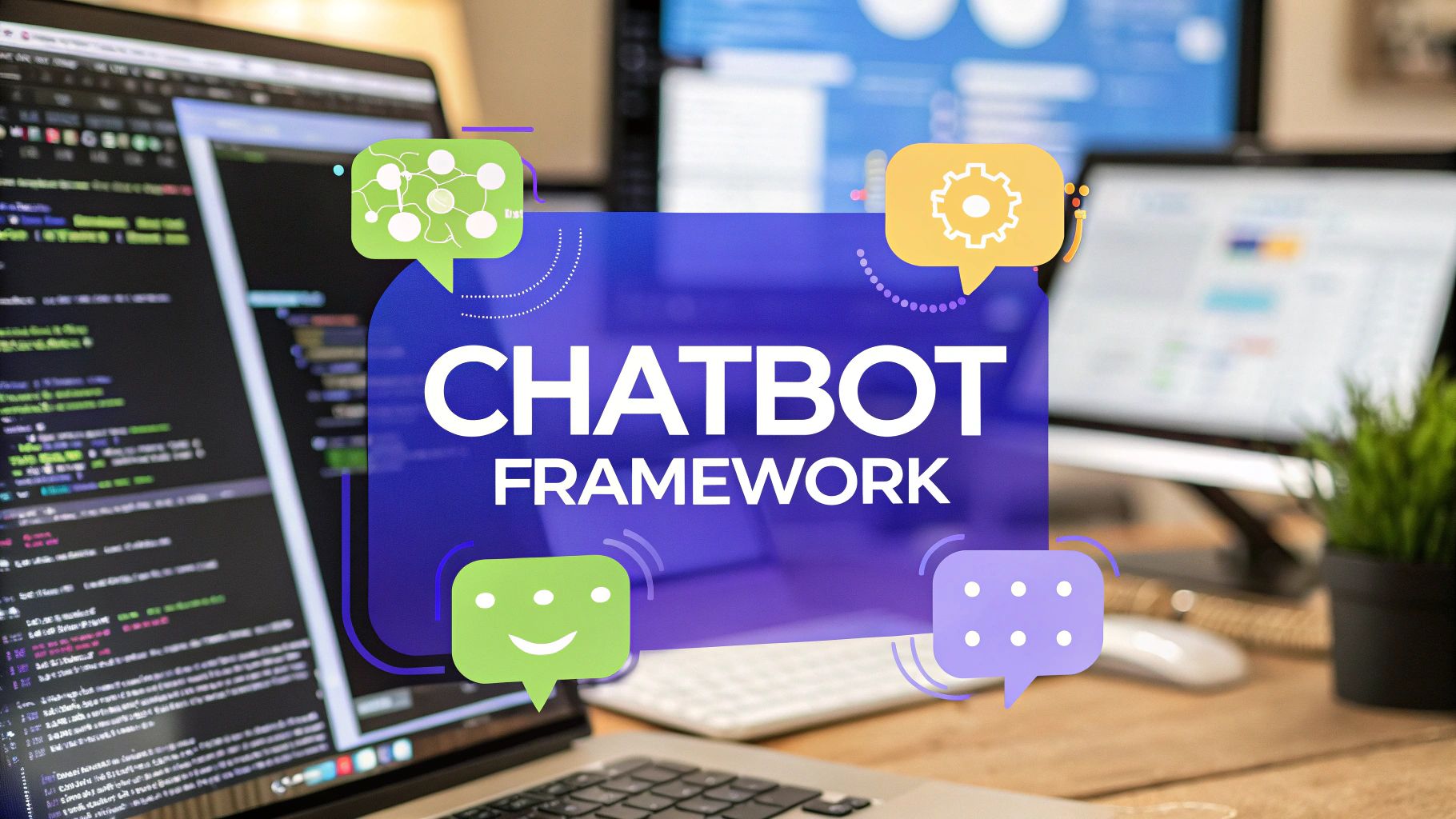A Guide to Chat Widgets for Websites
Discover how chat widgets for websites can boost sales and support. Our guide covers benefits, key features, and best practices for implementation.
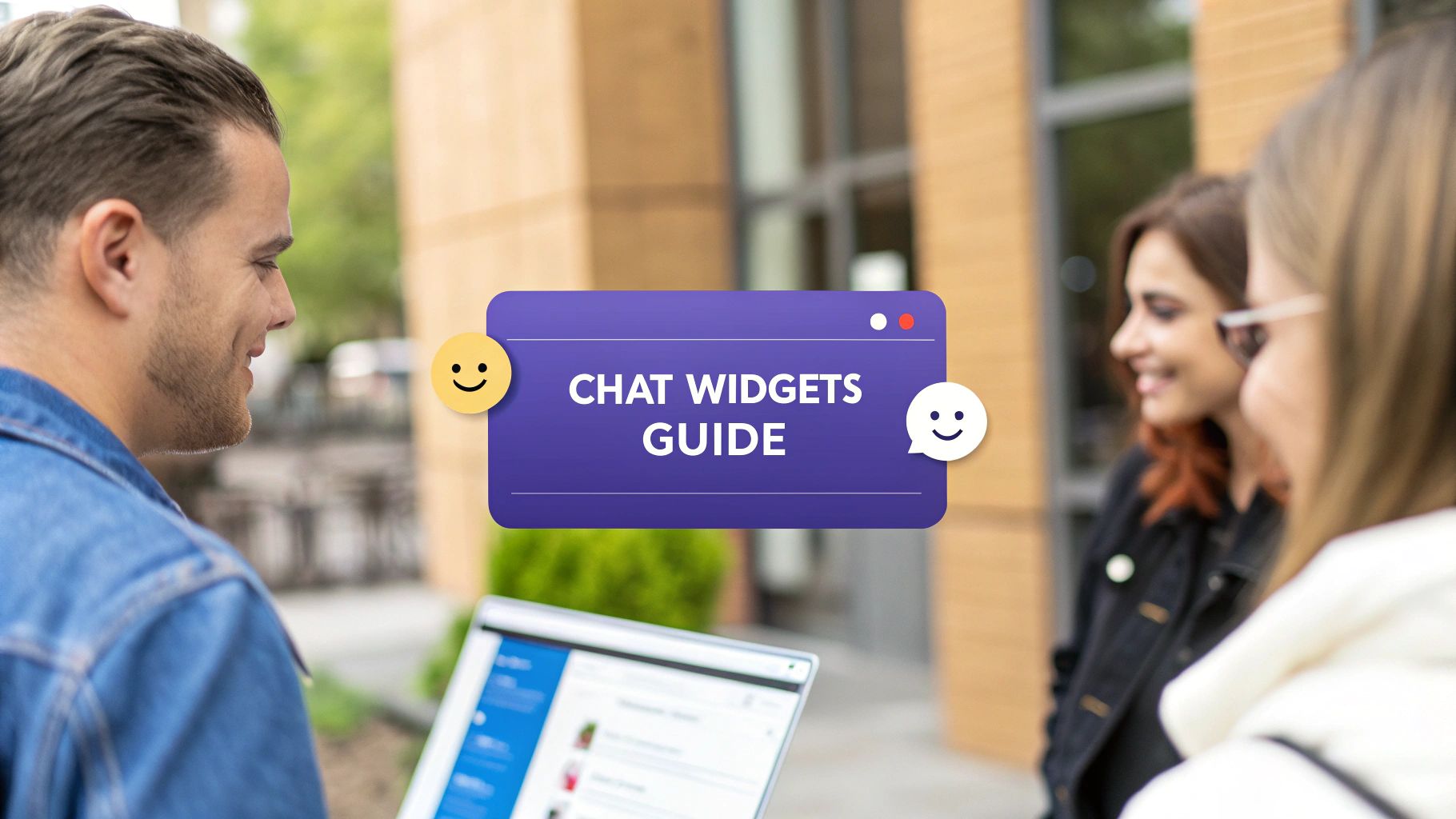
Think of the last time you were in a physical store. A helpful, friendly person probably greeted you, ready to answer questions or point you in the right direction.
A chat widget does the exact same thing for your website. It’s that small, interactive window, usually tucked in the bottom-right corner of the screen, that pops up to offer help. It turns a one-way digital brochure into a two-way conversation.
Instead of making visitors dig for a "Contact Us" page or wait hours for an email reply, a chat widget for your website offers an immediate connection. This is a game-changer, especially since 41% of customers prefer live chat over any other support channel. It simply meets the modern demand for speed.
What’s Really Happening Behind the Scenes?
At its core, a chat widget is all about opening a direct line of communication. But how that conversation is handled can look very different depending on your setup. That simple chat window can be powered by:
- Live Human Agents: Real people from your support or sales team who can navigate complex, nuanced conversations with a personal touch.
- AI-Powered Chatbots: Automated programs designed to answer common questions, qualify leads, or book meetings 24/7 without any human help.
- A Hybrid Model: A smart system where an AI chatbot handles the initial queries and then seamlessly passes the conversation to a human agent when a personal touch is needed.
This flexibility makes chat widgets a powerful tool for any business, regardless of its size or goals.
A chat widget transforms your website from a monologue into a dialogue. It stops being a static webpage and becomes an active, helpful part of your team, ready to engage someone the moment they show interest.
Adding one to your site isn't just about adding a feature; it's a fundamental shift in user experience. You're making your digital presence more responsive, personal, and much better at turning casual visitors into loyal customers.
Chat Widget Impact at a Glance
It's one thing to talk about the benefits of chat widgets, but the numbers tell an even clearer story. The data shows a direct link between implementing real-time chat and significant improvements in key business metrics.
Below is a quick summary of how these tools can affect everything from lead generation to customer satisfaction.
As you can see, the impact goes far beyond just being "helpful." Chat widgets are a proven tool for driving tangible growth, improving efficiency, and building stronger customer relationships.
The Real Benefits of Adding a Chat Widget
Putting a chat widget on your website is more than just opening up another way for people to reach you. It’s a strategic move that delivers clear, measurable returns across the board. The perks go far beyond simple convenience, directly impacting your bottom line by improving sales, elevating customer support, and boosting your team's efficiency.
Think of it as hiring a multi-talented employee who works 24/7 to grow your business.
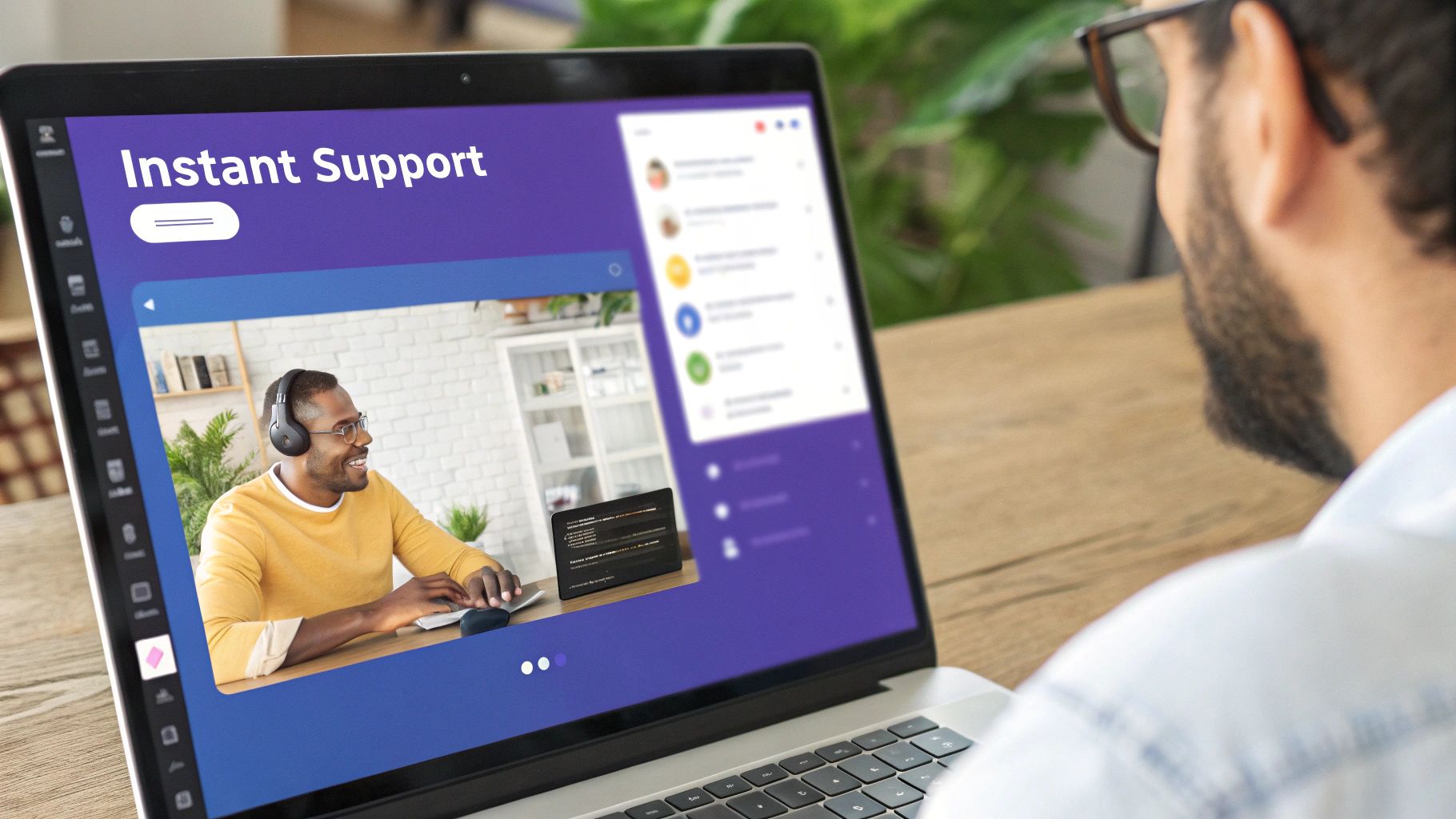
This single tool acts as your digital salesperson, support agent, and data analyst all in one, completely changing how visitors interact with your brand. The results are often immediate and significant.
Drive More Sales and Increase Conversions
One of the biggest wins is the ability to engage potential customers at exactly the right moment. When a visitor is stuck on a pricing page or hesitating at checkout, a proactive chat message can deliver the one piece of information they need to get over their uncertainty and hit "buy."
This kind of real-time assistance directly plugs a major hole where revenue often leaks.
The numbers don't lie. An impressive 63% of customers say they're more likely to buy from a site that offers live chat. It makes sense—chat provides instant answers, builds trust, and makes the whole buying process feel more personal and guided. To get started, you can check out our guide on how to add a chatbot to your website.
Elevate Customer Support and Loyalty
Today's customers expect support that's fast and easy. Making them hunt for a contact form or wait on hold is a recipe for frustration. Chat widgets offer the instant gratification that phone and email simply can't match, which is why satisfaction rates are so much higher.
Live chat conversations boast an impressive 87% positive customer satisfaction rating. This has a direct effect on repeat business, with 60% of customers more likely to return to a website that offers this kind of support.
This immediate, effective service builds a strong foundation of trust and reliability, turning one-time buyers into loyal advocates for your brand. In fact, 79% of companies report that implementing live chat has led to increased customer loyalty and revenue.
Boost Your Operational Efficiency
Beyond the customer-facing benefits, chat widgets also make your internal operations much smoother. By using automated responses or an AI-powered chatbot, you can instantly handle all the routine questions like "What are your business hours?" or "What's your return policy?"
This has a powerful two-part effect:
- Frees Up Your Team: It deflects all the common, repetitive questions, which allows your human agents to focus their expertise on more complex and high-value customer issues.
- Captures Valuable Insights: Every single chat conversation gives you data on customer pain points, frequently asked questions, and product feedback. You can use these insights to make your website and your products even better.
Choosing Between Live Agents and AI Chatbots
When you add a chat widget to your website, one of the first big decisions you'll make is who—or what—will handle the conversations. This isn’t about picking a clear winner between human agents and AI chatbots. It's more like a carpenter choosing the right hammer; you wouldn't use a sledgehammer for a delicate finishing job.
Each one serves a very different purpose. Figuring out their strengths is the key to building a smart communication strategy that actually helps your business grow.
The Case for Live Agents
A live human agent is your go-to for anything that requires empathy, complex problem-solving, or a bit of nuance. Think of them as your specialists for the high-stakes conversations that can make or break a customer relationship.
A real person is almost always the better choice in these situations:
- High-Value Sales: Guiding someone through an expensive or complex purchase often means building real rapport and catching subtle concerns that an AI would likely miss.
- Sensitive Support Issues: When a customer is frustrated, confused, or dealing with a delicate problem, the patience and understanding of a human can turn a bad experience into a great one.
- Complex Technical Questions: For those tricky issues that don't have a canned answer in a help doc, a skilled agent can troubleshoot in real time.
Bottom line: when a conversation needs a personal touch and adaptive thinking, a live agent is your best bet.
The Power of AI Chatbots
AI chatbots, on the other hand, are absolute workhorses built for efficiency and scale. Their biggest advantage is their ability to work 24/7 without ever needing a coffee break. This makes them perfect for managing a high volume of chats and automating all the repetitive, routine tasks.
This infographic can help you visualize which option makes the most sense based on your company's size, budget, and how fast you need to respond.
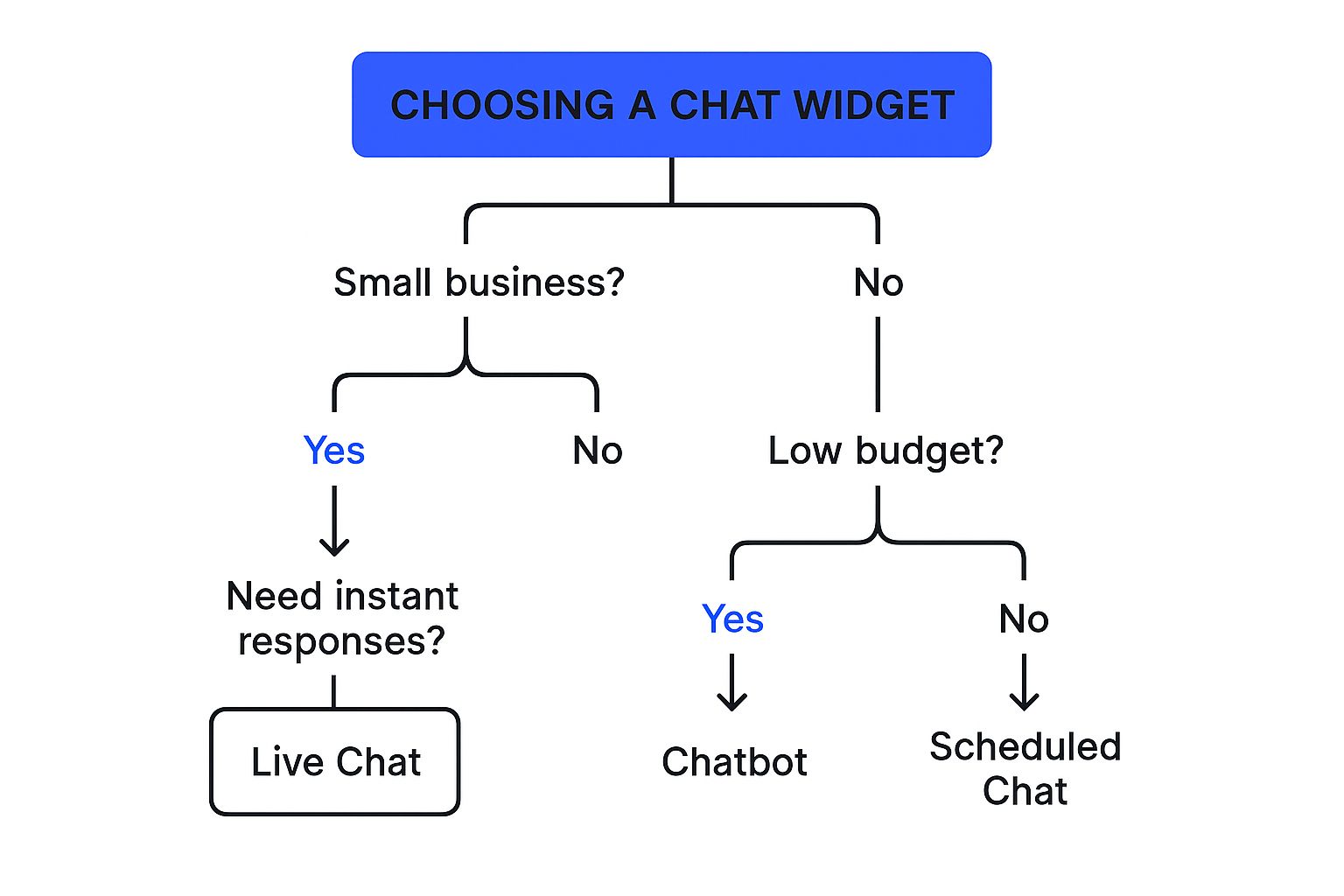
As the decision tree shows, chatbots are often the ideal starting point for smaller businesses or any company that needs instant, around-the-clock answers on a budget. And their adoption is surging for good reason. Today, around 58% of B2B companies use chatbots—a number that has jumped by 92% since 2019—making it a dominant channel for brand communication. When designed well, these bots can handle 80-90% of incoming queries. You can discover more chatbot adoption insights and see how they are changing the way businesses talk to customers.
A hybrid approach offers the best of both worlds. The chatbot acts as a first-response filter, handling common queries and gathering initial information, while human agents are freed up to handle only the most critical escalations.
This blended model creates a seriously efficient system. It guarantees that customers get instant answers for simple requests, while ensuring that the more complex issues get the expert human attention they deserve. It's all about maximizing the strengths of both AI and your team to deliver a seamless experience.
Must-Have Features in a Modern Chat Widget
Not all chat widgets are built the same. While basic messaging is a start, a modern tool offers a suite of features designed to automate engagement, improve your team's workflow, and deliver real, measurable results.
Think of it as the difference between a simple walkie-talkie and a sophisticated communication hub for your entire business. To make the right choice, you need a clear checklist of what truly matters. These are the non-negotiable features that separate a basic chat box from a powerful growth engine.
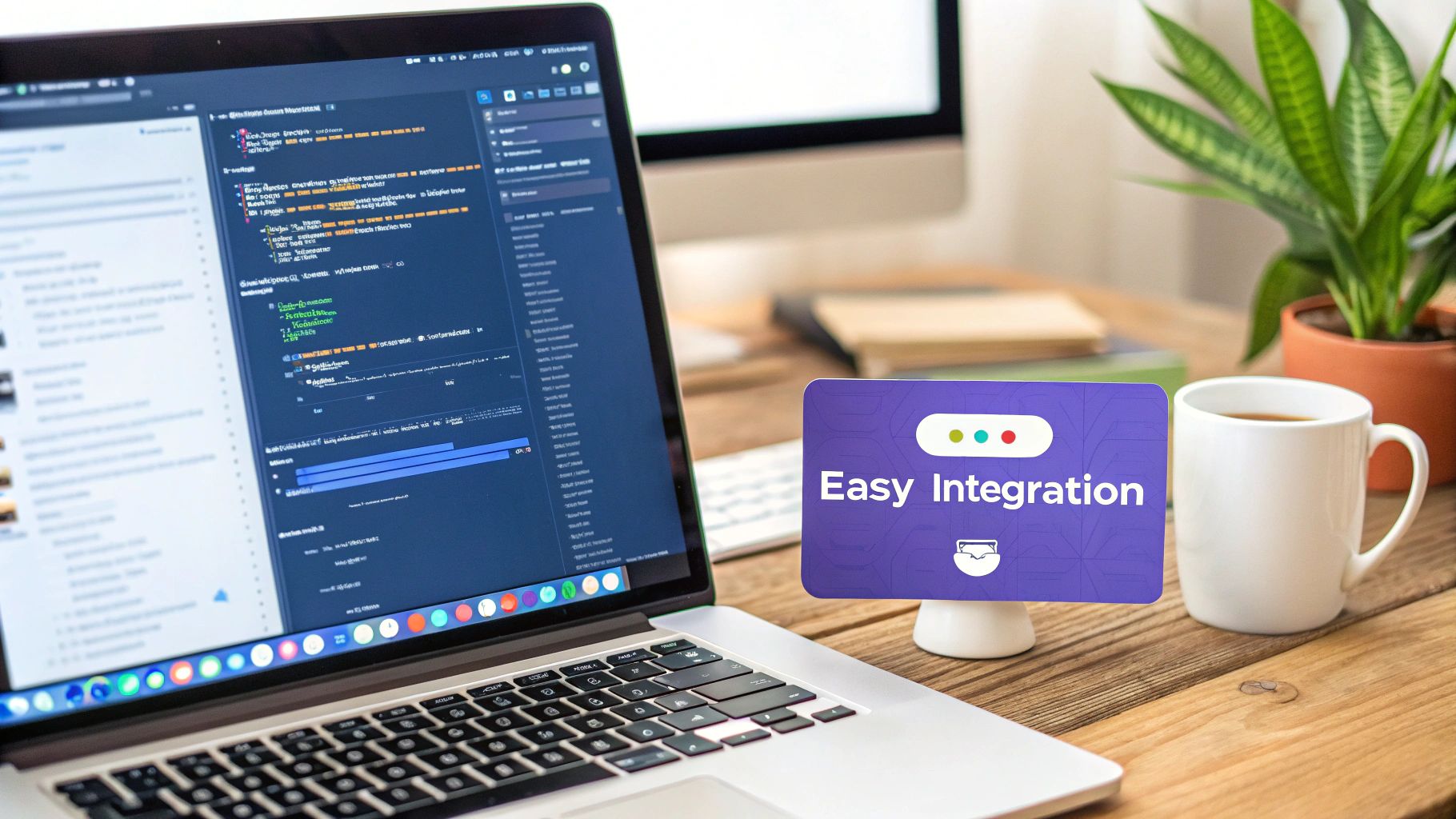
Proactive Engagement and Smart Routing
Waiting for a visitor to start a chat is a massive missed opportunity. The best chat widgets use proactive chat to automatically start conversations based on specific behaviors.
For example, a message can pop up when a user spends more than 30 seconds on your pricing page or has a high-value item in their cart. This simple nudge can make all the difference in preventing cart abandonment.
Equally important is intelligent chat routing. This feature acts like a smart receptionist, automatically sending conversations to the right person or department based on the visitor’s initial question. A sales question goes to the sales team, and a technical issue goes straight to support, ensuring customers get expert help, faster.
Tools for Agent Efficiency
Your team’s time is valuable. Features that boost efficiency are essential for providing fast, consistent support without burning out your agents.
- Canned Responses: These are pre-written answers to frequently asked questions. Instead of typing the same reply over and over, agents can answer common queries with a single click, dramatically cutting down response times.
- Chat Transcripts: Having a saved record of every conversation is a game-changer for quality control, training, and follow-ups. Agents can easily review past interactions to provide more personalized and informed support.
A well-equipped chat widget empowers your team to handle more conversations effectively. This not only improves customer satisfaction but also makes your support operations far more cost-efficient, as agents can manage multiple chats at once.
Critical Integrations and Analytics
A chat widget shouldn't operate in a silo. It needs to connect seamlessly with the other tools you already use every day.
Robust integration capabilities allow you to sync chat data with your CRM, help desk software, and marketing automation platforms. This creates a unified view of the customer journey and automates things like lead capture, saving your team from manual data entry.
Finally, you can't improve what you don't measure. A comprehensive analytics dashboard is crucial for tracking performance. It gives you key metrics like chat volume, first response time, and customer satisfaction scores (CSAT). This data gives you the insights needed to refine your strategy, prove ROI, and ensure your chat widget for your website is delivering maximum impact.
You can learn more by exploring our detailed guide on what makes a great chat widget for a website and how to choose the best one.
Getting the Most Out of Your Chat Widget
Just dropping a chat widget onto your website isn't a strategy. It's a start. Real success comes from a thoughtful setup that actually syncs up with what your visitors are doing and what your business needs to achieve. The line between a helpful assistant and an annoying pop-up is finer than you think, and it all comes down to a few key decisions you make upfront.

Think of your chat widget like a great retail employee. They don't run up to every single person the moment they walk through the door. Instead, they observe, look for cues, and step in to offer help when it's most likely to be welcomed. Your widget should work the same way.
Nail the Placement and Triggers
Where and when your chat widget shows up is everything. The standard bottom-right corner is a safe bet—people are used to seeing it there, and it doesn't block the important stuff on your page. The real art, however, is in the timing.
Instead of hitting every visitor with a generic pop-up the second they land on a page, you need to use intelligent triggers based on their behavior. This makes your outreach feel helpful, not pushy.
Here are a few ideas:
- Time on Page: Engage a visitor who has spent more than 45 seconds on a high-value page, like your services or features list. This shows they're genuinely interested.
- Specific Page Visits: Pop up with a custom message on your pricing page. Something like, "Need help comparing plans?" can be incredibly effective.
- Cart Value or Abandonment: Proactively offer help when a user has a high-value cart or looks like they're about to leave the checkout page without buying.
This contextual approach isn't just a nice-to-have; it delivers serious results. In fact, data shows that adding a chat widget during checkout can boost the average order value by a whopping 43%. And with 44% of users saying real-time responses are the most valuable feature a website can offer, a well-timed chat can be the one thing that closes the deal. You can discover more live chat statistics from LLCBuddy to see the full impact.
Craft Compelling Opening Messages
That first message your widget sends sets the tone for the entire conversation. "How can I help you?" is okay, but you can do so much better. A personalized, context-aware opener is where the magic happens. Try tailoring your greeting to the specific page the user is on.
On a product page: "Have any questions about the features of Product X? I'm here to help."On a pricing page: "Finding the right plan can be tricky. Would you like a hand comparing our options?"
See the difference? These small adjustments show you're paying attention and make users far more likely to respond.
It’s also smart to be upfront about response times. If you have a live team ready to go, say so. If it’s a bot, set that expectation from the start. A little honesty goes a long way in building trust. Finally, always ask for feedback after a chat. A simple post-chat survey can give you incredible insights into what's working and where you can improve, turning every conversation into a chance to get better.
Common Questions About Chat Widgets
Even after seeing all the benefits, it's natural to have a few questions before adding a new tool to your website. We get it. Concerns about cost, performance, and proving its value are completely normal for any business making a strategic move.
So, let's clear up the most common questions we hear about chat widgets for websites. Our goal is to give you clear, straightforward answers so you can move forward with confidence.
How Much Does a Chat Widget Cost?
This is usually the first question on everyone's mind, and the answer is a lot like choosing a mobile phone plan: it really depends on what you need. There isn't a single price tag, since costs are tied directly to the features and scale you're looking for.
Most providers offer a free forever plan, which is a fantastic starting point for small businesses or solo operators. These plans usually give you basic chat for one or two people but might cap the number of conversations you can have each month.
Once you step into paid tiers, you’ll see plans built around the number of agent "seats" or the total volume of monthly chats. The price generally goes up as you unlock more powerful features.
- Proactive Chat: The ability to automatically pop up and engage visitors based on what they're doing on your site.
- AI Chatbots: Access to automated, 24/7 support that can handle questions while you sleep.
- Integrations: The power to connect your chat widget to your CRM, help desk, and other tools you already use.
- Advanced Analytics: Deep-dive reports on agent performance, customer happiness, and more.
At the top end, enterprise plans offer the whole package—dedicated support, advanced security, and unlimited customization for large-scale operations with complex needs.
Will a Chat Widget Slow Down My Website?
This is a critical question, and a totally valid one. Nobody wants to boost engagement only to kill their website performance. After all, even a one-second delay in page load time can hurt conversions.
The good news is that modern chat widgets are built to be incredibly lightweight.
Most are designed to load asynchronously. Think of it this way: when your website loads, it doesn't sit around waiting for the chat widget to be ready. The widget loads independently in the background, so your main content appears just as fast as it always has.
To keep things running smoothly, here are a few best practices:
- Choose a Reputable Provider: Established chat software companies pour resources into optimizing their code for speed.
- Use a Tag Manager: Putting the widget code into a tool like Google Tag Manager can help you manage how and when scripts load.
- Test Your Site Speed Regularly: Use tools like Google PageSpeed Insights to check your performance before and after you install the widget.
When you do it right, a chat widget should have almost no noticeable impact on your site's speed. You get all the benefits without the performance headaches.
How Do I Measure the ROI of a Chat Widget?
Proving the return on investment (ROI) is what separates a nice-to-have tool from a must-have one. With a chat widget, the value is often crystal clear and can be tracked through several key metrics that tie its use directly to business growth.
The real power of a chat widget isn't just in answering questions; it's in its ability to generate measurable business outcomes. You can directly connect chat interactions to increased sales, more leads, and higher customer satisfaction.
To figure out your ROI, you'll want to focus on tracking these specific areas:
- Lead Generation and Conversion Rates: Keep an eye on how many new leads you capture through chat. Many platforms even let you see which conversations led directly to a purchase or a signup. For a deeper dive, our guide on using a chatbot for lead generation offers some great strategies.
- Customer Satisfaction (CSAT) Scores: Use quick post-chat surveys to ask people to rate their experience. Higher CSAT scores are a great indicator of customer loyalty and repeat business.
- Reduced Support Costs: Measure how many routine questions are handled by a chatbot, freeing up your team. Or, track how many more conversations a single agent can manage via chat compared to phone or email. This shows a clear win in operational efficiency and cost savings.
By tracking these metrics, you can build a powerful business case that shows your chat widget isn't a cost center, but a genuine revenue driver.


